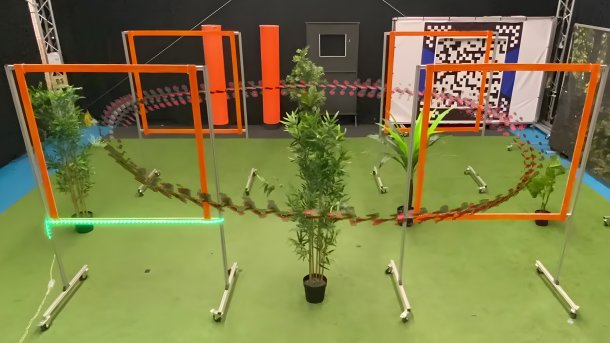ESA: How AI controls of race drones can be used for spacecraft
Autonomous racing drones can fly at high speeds without colliding. Researchers want to use their AI control for spaceship control.

A race drone with AI control based on neural networks autonomously completes a course. The drones are to be used for spaceship control tests.
(Image: TU Delft)
The European Space Agency ESA is interested in what is happening at Delft University of Technology's (TU Delft) "cyber zoo". ESA is particularly interested in the control of race drones based on artificial intelligence (AI). The algorithms of the control systems used there could also be used in a similar form in spaceships in the future, to carry out spacecraft maneuvers much more efficiently than before.
A 10 m × 10 m test track at TU Delft's "Cyber Zoo", which is run by the Faculty of Aerospace Engineering, is a busy place. Human-controlled racing drones - so-called micro air vehicle quadcopters - and autonomous versions fly through the air together. The autonomous drones are trained to complete a course in the shortest possible time. In doing so, they must constantly determine their own position in order to derive a flight path with the help of AI that does not lead to collisions.
ESA's Advanced Concept Team (ACT) worked together with the Micro Air Vehicle Laboratory (MAVLab) at TU Delft to investigate how such autonomous control systems can be used for all kinds of challenging spacecraft maneuvers. They have summarized the results in the study "Optimality principles in spacecraft neural guidance and control", which has been published in Science Robotics. ESA is focusing in particular on the flight control of spacecraft during interplanetary transfers, landings on the surface of planets and docking processes.
"In space, every resource on board must be used as efficiently as possible - including fuel, available energy, computing resources and often time. Such a neural network approach could enable optimal on-board operations and increase the autonomy and robustness of the mission. But we needed a way to test it in the real world before planning actual space missions," says Dario Izzo, scientific coordinator of the ACT.
The scientists have identified race drones as a suitable test environment to try out neural control architectures in reality.
Determining the optimal spacecraft trajectory with neural networks
Normally, spacecraft maneuvers are planned in detail on the ground, then uploaded to the spacecraft and executed on it. The mission is managed from the ground, with the spacecraft taking control. However, space is "unpredictable by nature". There are many different factors that can influence the planned maneuver, such as gravitational fluctuations, atmospheric turbulence or the nature of the planetary body. In this case, the modeling that was used on the ground to plan the maneuver is not sufficient. If the spacecraft deviates from the planned orbit, it has to carry out resource-intensive recalculations to get back on course.
Instead of adhering to a single pre-calculated course, the scientists want to have the spacecraft determine its optimal trajectory itself again and again based on its current position - similar to what autonomous racing drones do. To achieve this, the researchers are using Guidance & Control Networks, or G&CNets for short, for neural-based control. This type of spaceship control is much more efficient, say the scientists. All calculations then take place on board the spaceship.
"When it comes to racing, the main scarce resource is of course time, but we can use this as a proxy for other variables that may take priority in a space mission, such as fuel mass. Satellite CPUs are quite limited, but our G&CNets are surprisingly modest, they can store perhaps up to 30,000 parameters in memory, which is possible with only a few hundred kilobytes and less than 360 neurons in total."
The G&CNet should be able to directly control the actuators, i.e. the spacecraft's engines and, in the case of drones, the propellers. This is a major challenge, as there is a large discrepancy between the actuators in the simulation and the real actuators.
Read also
Autonome Drohne fliegt Piloten davon
"We deal with this by identifying the reality gap during the flight and teaching the neural network how to deal with it. For example, if the propellers give less thrust than expected, the drone can detect this via its accelerometers. The neural network will then regenerate the commands to follow the new optimal path."
The researchers now want to use the racing drones to try out the G&CNet approach. A demonstrator for a space mission will only be planned once a solid system has been set up and validated.
(olb)